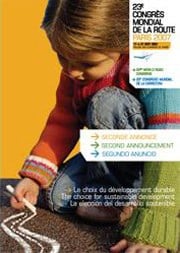Road pricing as an instrument of environmental policies – Norwegian experiences
Historical archive
Published under: Stoltenberg's 2nd Government
Publisher: Ministry of Transport and Communications
Speech/statement | Date: 17/09/2007
By Former Minister of Transport and Communications Liv Signe Navarsete
Opening remarks at Minister’s session (round table 1), PIARC, Paris, 17 September 2007.
 Opening remarks at Minister’s session (round table 1), PIARC, Paris, 17 September 2007
Opening remarks at Minister’s session (round table 1), PIARC, Paris, 17 September 2007
Ladies and gentlemen: I am very glad our French host organization has put road pricing on the agenda for this ministers’ session and succeeded in bringing together so many high officials from all over the world. Let me briefly share some thoughts and experiences on road pricing with you:
Most cities experience every day traffic jams together with increasing CO2 emissions and noise. The recent signs of climate change raise a debate on the environmental issue, in particular related to road transport emissions. People seem to be concerned about this everywhere, and various measures to deal with the problem are discussed.
Economists have recommended road pricing to solve congestion related problems for decades. They argue that congestion charging helps solving two problems simultaneously: improve the traffic flow and consequently reduce air pollution. Furthermore, a nice side benefit for any government is the potential income.
My country Norway has experience from numerous road pricing schemes in the sense of toll roads and urban rings. Tunnels, bridges, highways and also public transport infrastructure have been financed and completed sooner than they would have been with traditional public spending. This is now an important part of our road infrastructure policy.
The charging was introduced as a financing instrument with flat rates and did hardly change people’s mobility habits. Tolls alone – typically 2 Euros for entering a city road network in Norway – do not remove congestion and consequently not the emissions, either. In some cases, there might have been a slight shift from car use to other modes thanks to improved conditions for public transport, cycling and walking. But there is hardly any significant impact on the environment. However, our electronic tolling system has allowed research on time differentiated charging, and the studies confirm the theory: It is possible to change people’s transport habits through the pricing mechanism.
My government has introduced various environmental policy measures in the road transport sector using the pricing mechanism. For instance, the tax system is designed to enhance the use of alternative, low-emission fuels. This policy has already been successful. Further, we recently presented a new white paper on climate policy with proposals for concrete new measures to reduce greenhouse gas emissions. One of these measures is to invite the largest towns to cooperate on reducing local emissions, especially those from road traffic.
Many politicians cry for better public transport service and lower fares, but they ignore that (most) people change their transport habits very slowly. I believe we need both carrot and, unfortunately, stick. That is why I regard differentiated road pricing in the sense of congestion charging as an important and adequate instrument for the future.
We have seen that congestion charging proved to work very well for traffic management purposes in cities like Stockholm and London. In order to have success, good information is crucial, and I think it is important for the acceptance that the users perceive the following:
a) the problem before introducing any road pricing,
b) improved conditions for alternative modes, for example better public transport service
c) less congestion and more predictability on the road network
On national level, the legal basis for congestion charging is already prepared in Norway. Over the last weeks I have also perceived a slight positive shift in the public opinion, but according to the subsidiarity principle, local political will is an important condition for the introduction of road pricing. I therefore wait for further steps from the municipalities, while keeping an eye on the development around us. And I know one thing for sure: The future will bring changes and challenges – not least in the road transport sector.
Thank you for your attention.
PIARC (World Road Association) - Paris 2007 Congress homepage